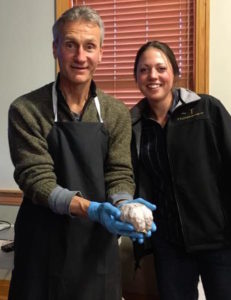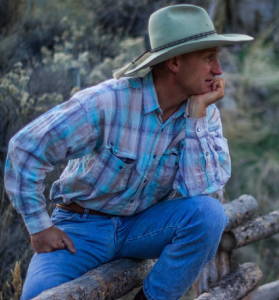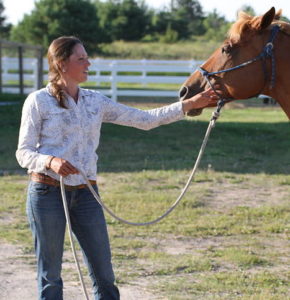Say what you will about Facebook. Occasionally, a productive conversation on the social media platform can illuminate and educate.
That’s what happened when Cayuse Communications contributor Amy Skinner posted this video of a horse in training.
 She asked several professionals, including Warwick Schiller and Dr. Steve Peters, for feedback. What followed was excellent insight on how, by paying more attention and doing more waiting, we can get positive results from challenging situations.
She asked several professionals, including Warwick Schiller and Dr. Steve Peters, for feedback. What followed was excellent insight on how, by paying more attention and doing more waiting, we can get positive results from challenging situations.
CLICK ON IMAGE (at right) TO WATCH VIDEO
Check out the conversation here:
Amy Skinner: This anxious mare carries a tight jaw. I started focusing today on jaw release and thought this was an interesting video of the progression of a lick and chew. I shortened the video. The original is eight minutes. That’s how long it took for her nervous system to come down enough to lick and chew. After that they started rolling out much easier throughout the session.
It is a great example of the progression in facial expressions leading up to a lick and chew. They are important not to miss:
- slow blinking
- head bobbing
- changes in breathing
- lip twitching, etc.
Steve Peters: The tight jaw may be one of the last places that the horse releases before completely moving from the sympathetic to parasympathetic nervous system.
Usually, people don’t wait long enough for the horse to loosen up and begin to lick and chew. People often feel they need to be doing something with the horse before it has finally let loose, but the wait is well worth it and as you can see it really pays off.
Amy Skinner: Thanks, Steve!
 Warwick Schiller: How did you trigger it Amy? I have spent most of the year working on getting their attention momentarily, like having them mentally present for a split second, and the twitching will start. Then its a matter of being present, and waiting for the magic to happen. I have had mustangs that have never laid down in the presence of a human lay down at clinics and go to sleep.
Warwick Schiller: How did you trigger it Amy? I have spent most of the year working on getting their attention momentarily, like having them mentally present for a split second, and the twitching will start. Then its a matter of being present, and waiting for the magic to happen. I have had mustangs that have never laid down in the presence of a human lay down at clinics and go to sleep.
Amy Skinner: This mustang panics and bolts a lot, so I’d lunge her in a circle until it got a little better, then stop and wait for a while til she relaxed. At first, it helped if I led her forward one step or back one step and at one point I just sat down and waited. She just needed time I think
Warwick Schiller: I have found asking them to do something with JUST enough pressure to get them to flick their attention to you (so physical response is not really important) triggers the process, and doesn’t send them further up the sympathetic scale.
Amy Skinner: Yes, you can see in this video her attention leaves a few times. All I did was touch the rope and she came back to me and eventually chewed. Cool stuff!!

Amy Skinner
Warwick Schiller: I have found that once the twitching starts, it works better if you no longer keep their attention. It seems it interrupts the cycle of coming down. I have had many people at clinics this year whose horses have never really come down.
That jolt at around 1:30 is interesting. I saw one horse this year that looked like it had been hit with a cattle prod. It was an extremely shut-down Gyspy Vanner/Cob, and right before she let down, the jolt happened.
Amy Skinner: Yes, she does that when she is trying to let down! That’s why I had to video and show her progression
Elaine Hanscom: Is the “jolt” she does at 1:30, what you guys mean by “twitching”? Or can you explain “twitching”? This is really good stuff!
Amy Skinner: What I meant by twitching is her lower lip and ears before and after the jolt. It’s subtle.
Steve Peters I don’t want to get too complicated but Warwick is right in that the horse has what is called the Reticular Activating System in the brain stem where it processes all incoming stimuli and decides what it will pay attention to. Some horses can fool you, remain tight, and check out on you. You may need to just move back to the head of the line in what the horse is processing by getting their attention. This is very subtle and not enough to send them back up into the sympathetic range. As you both describe, they will start to let down and then not completely trust the feeling and temporarily jolt back out of the transition towards a more relaxed state.
Amy Skinner This is so cool, thanks for chiming in, Warwick and Steve.
Tammy Hannah Lamphere What would be the next thing to do or not do after she releases? Take a walk or just sit even longer or call it a day?

Amy Skinner, Dr. Steve Peters, and a horse brain
Amy Skinner: What I did was lunge a circle or two, wait for lick and chew, lunge again, wait for lick and chew. Eventually she began licking and sneezing while lunging and that’s where I called It a day.
Amy Skinner: Steve and Warwick your thoughts here please: There is a danger, I think, in teaching the horse the release is after the thing has happened, not release and relaxation while the thing is happening.
I’ve been experimenting with this over the last year and starting to formulate better conclusions but I’m interested in your thoughts…In other words, I don’t want the horse to learn to relax becauseI quit doing something, but to find relaxation while doing something
Tammy Hannah Lamphere This whole thought of relaxing while engaged is something I’ve wondered about forever but didn’t know how to get there.
Warwick Schiller: What I have found with horses that have learned how to shut down is that first we have to teach then HOW to let down.
Initially they stop and we have to wait for a long time for them to come down, but that time gets shorter and shorter, and eventually they will let down WHILE they are moving. But, its a process and you can’t get the let down while they are moving, if they cant let down. One of the episodes of The Principles Of Training was called Create A Tool Before You Use A Tool, and this would be a case of that.
Amy Skinner: Warwick, I was hoping you’d say that. We’ve had some tough horses this year and I’d like to go back to the ones I had this time last year and do them over…but I think this stuff helps tremendously

Steve Peters
Warwick Schiller: I’d like to go back to every horse for the past 25 years….
Steve Peters: Once your horse knows it can get to the good neurochemical state, it will start to seek out ways to get back there. At that point it is just up to you to either stay out of its way or set it up/direct it or allow your horse to find it no matter what it is doing. Initially, you have to help them find the bar and get a good cocktail then you can serve up drinks wherever.
Maddy Butcher: A few minor comments that I humbly make amongst all these pros:
- Especially with my challenging mule, waiting is key. I’ve begun to recognize the cascade of signs (before licking and chewing) that show me the transition from sympathetic to parasympathetic (those signs you mentioned already, Amy).
- The higher the stress, the greater the relief, which, of course, is another GREAT argument for the benefits of discomfort (if you wait for the horse to have relief). Like how I love not flying in a plane, but only appreciate it after flying.
- Bryan Neubert once mentioned that Tom Dorrance would actually rub the gums of a stressed and challenged horse, kinda kickstarting the release to relief process. On rare occasion, I’ve done this with my mule and it’s helped her with letting go/letting down.
Amy Skinner: We have also helped along a lick and chew for horses that were just stuck. Freckles was one who needed a boost and then could find It for herself. It’s all about drugs, like my dear mother always told me.

Warwick Schiller I have found that a hyoid release is a great tool.
Amy Skinner: This has been fun, guys, thanks for your great comments
Elaine Hanscom: My friend also rubs the gum or under tongue area, to get the hyoid release and a reminder (is this considered a crutch? I’ve seen it work well to remind the horse and help it)
Amy Skinner: I don’t mind doing it to start out if they are very tight and don’t know how to find It, but after a bit they need to seek it out. If I have to keep doing it, it means I’ve missed something
Warwick Schiller: I’m with you Amy. I don’t mind helping them find it initially if they are very tight , but I think that all that does is get the let down . But if you can trigger the let down through their focus , then the waiting become a huge factor in getting a connection with them. That waiting is like a man sitting outside the dressing room in a dress shop while she is trying on dresses. He’s not doing anything, but he is building connection.

Amy Skinner
Maddy Butcher: Also, Warwick, here is an article you might like on attention
Warwick Schiller Thanks, Maddy
Elaine Hanscom That pyramid visual is BRILLIANT! Great article. Wish more folks understand how important this stuff is.
Julie Kenney: Great processing of information here Amy! Thanks for starting the conversation.
Great read, guys! I’m new to ground work and horsemanship so these tips are great. I find the Masterson method works well for my mere when she’s really tense. But I’m think she is learning to release on her own. For example, when doing ground work she’ll go to the bathroom, sigh, mouth quivers and then the yawn. Yes, she will check out occasionally and I’m working on getting her focus back – it’s my fault and it’s a work in progress- but are there other signs I should look for? And how long should I let the come down or release last for? I think my issue is I let it go too long….?
LOVE reading this all over again. It was so fun to follow the conversation in “real time” on social media. The folks that contributed with their expertise, knowledge, and questions made it quite exciting. It was the next-best-thing to being in an arena together, with the horse, experiencing it in person. Thanks again, Amy, for starting the conversation!
Great discussion. FYI Linda Tellington (TTouch) does a lot of mouth work, muzzle, nostrils, gums. I’m working with just a pasture horse now that, for a horse that does nothing, has a ridiculously tight mouth. Just for fun. After I ride I always give my mare a good, rubbery muzzle rub so she does’t hold onto any tension from the ride. She’s usually relaxed, but just carrying the bit is muscle work.
I am transitioning from my 1/2arab/1/2quarter horse mare. I brought her into the world and was with her last april as she left this world. Last August I bought an appendix, Copper is her name, a victim of heard reduction. She is fifteen and herd bound. She used to shut down internally quite a lot. Her curiosity had been knocked out of her, unintentionally I am sure. So as with most of us, she came with baggage, a pretty large suitcase actually. My first task was to revitalize curiosity. Even though I was well aware of the licking/chewing, yawning, head down aspects of relaxing, coming down,etc having been a student of the Parellis for 14 years, I simply was not waiting long enough for her to process. My previous mare had conditioned me by going to the “bar” instantly. The first time she licked/chewed took
about the same as Amy’s mustang. From then on progress took off like a rabbit.
But I had not seen her yawn until two weeks ago- I am not sure she ever yawned because she looked rather puzzled as her mouth reluctantly opened slightly. The first one was a small yawn but made my heart happy.
As the others have said this “stuff” is so cool and the work Steve Peters is doing is fascinating. I liked Warwick’s analogy.
Cheers & keep lickin’
Thanks to you Amy, and all of your professional friends for this very intellectual discussion on the finer points of feel and timing. We all learn via repetition; it’s so useful to be reminded that there are steps along the way to the ‘big’ result (in this case the true release of tension in the jaw) just as there are ‘steps’ (i.e. warnings) along the way to the ‘big’ response for the undesired behavior (bucking, rearing, bolting, etc). As you all point out, it’s so important to acknowledge each of those steps (taking the time to learn horse body language, rewarding the littlest try), of ‘knowing’ [learning] when to quit, to make sure that the desired behavior becomes the learned, go-to behavior for each horse. As a favorite mentor used to say, “feel and timing can’t be taught, but it sure can be learned.” Even by us non-intellectual-types.